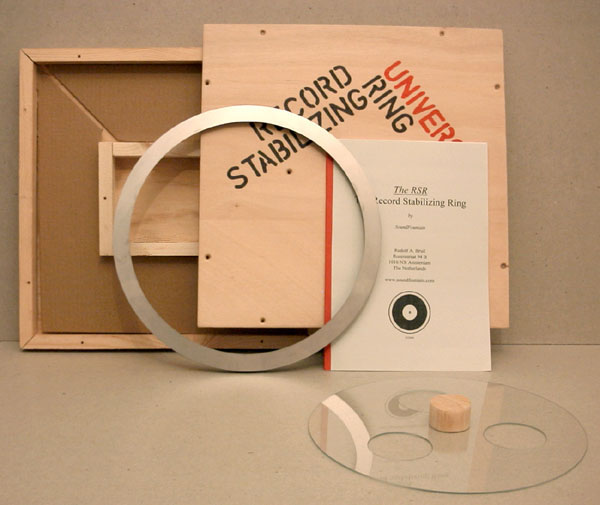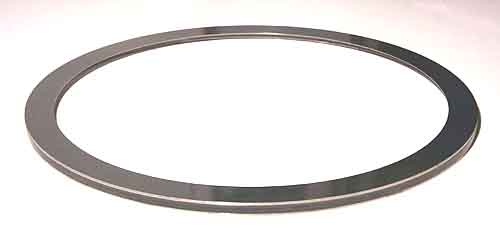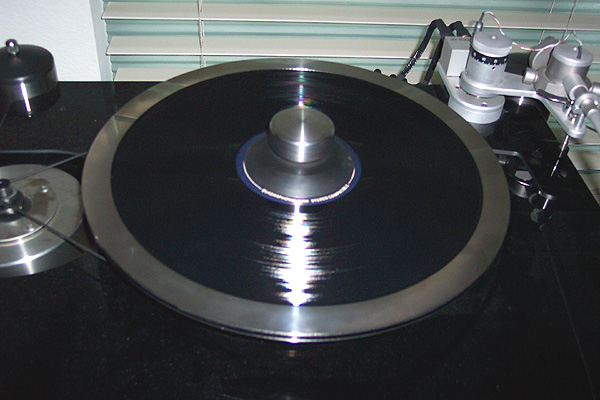|
You are reading the older HTML site
Positive Feedback
ISSUE
20
To Clamp or Not - the URSR LP Clamp
One of the age-old questions in audio is whether it is better to clamp LPs or not to clamp them. Many turntable manufacturers provide no mechanism other than gravity by which to hold an LP against the platter. Others provide clamps, and even offer periodic upgrades to their clamps. The audio aftermarket also offers a bewildering array of clamps to fit just about any turntable ever built, to correct the manufacturer's oversight or to augment their design skills. Which clamp is best for all turntables? That is like asking which are the best interconnects—there is no correct answer. There is not even agreement about whether record clamps improve the sound. Fortunately, the world of periphery clamps is not so complicated. Very few turntables come with periphery clamps, and there are very few aftermarket periphery clamps. This is both surprising and understandable. Periphery clamps, unlike regular LP clamps, have universally recognized benefits. Because they are placed on the outer edge of LPs, periphery clamps flatten out record warps. If the clamp is heavy enough, all but the most severe warps can be dealt with. A periphery clamp also increases the mass of the platter, and a heavier platter is less prone to speed fluctuation because it has higher inertia. Of course, where the additional weight is placed is important. Adding mass to the center of the platter much less effect on inertia than placing it on the outer edge. Why, then, don't all turntables come with periphery clamps? They have drawbacks. The first is weight. While a 3-kg periphery clamp will flatten most record warps, adding that much weight will cause problems with most suspended turntables. Even with a non-suspended turntable, the additional weight may stress the spindle bearing. Aside from the mechanical drawbacks, there are also human factors. Using a periphery clamp takes additional time. It is also possible to snap off the cantilever of your cartridge by snagging it on the periphery clamp when moving the arm across the LP.
Is a periphery clamp worth the time, effort, and risk? Let me describe my experiences with the Universal Record Stabilizing Ring (URSR) sold by Rudolf A. Bruil, a Dutch record enthusiast. Bruil's clamp is designed to fit on virtually all turntables. Most periphery clamps will only fit platters of a certain size because they have an L-shaped cross section, with the short side of the L going on the outer edge of the LP and the long side going on the outside of the platter. Instead, the URSR is a flat ring that sits on top of the LP, so the diameter of the platter is irrelevant. If you consult Bruil's website, you will learn that he experimented with rings of various weights, and learned that a ring weighing 550 grams was heavy enough to flatten most warped LPs but light enough not to upset the suspension of most suspended turntables. The URSR therefore weighs 550 grams and can be used with most turntables, suspended or not, with the following limitations: 1. Maximum platter diameter should not be greater than 318 mm. 2. The distance from the spindle to the arm base should be at least 170 mm. 3. With belt-drive turntables, there should be at least 7 mm between the top of the platter and the belt. In addition, the URSR will not work with vintage cartridges like Deccas and old Ortofons, which have very short cantilevers. These cartridges will not be able to play the opening grooves of an LP if a URSR is in place, as the bottom of the cartridge will hit the URSR rather than riding above it. The URSR appears to work with all tonearms except the Triplanar, which has an extension below the armwand that hits the URSR as the armwand moves toward the center of the LP. I have a VPI TNT-V HR turntable with a VPI 12.5 tonearm and cartridges with standard-length cantilevers, so none of the above limitations apply to me. I ordered a URSR from Mr. Bruil over the web. It arrived in less than a week, securely packed in a wooden box. The fit and finish of the URSR is very good. It is made of acrylic sandwiched between two rings of stainless steel. Stainless steel is non-magnetic, and will not interfere with the magnets inside cartridges. Also included in the box was a thin circle of acrylic and a round wooden puck. These items are used to center the device on the LP. The instructions tell you to glue the puck onto the center of the acrylic circle to provide a handhold that makes it easy to place and remove the acrylic circle on the platter. Do you need to use this centering tool to place the URSR precisely on the LP? No. A friend and I experimented with locating the URSR both with and without the centering device, and though we found that the centering tool sped up the process, we found that we could accurately center the URSR without the tool.
The first LP I played was the Cardas Test Record. My copy of this disc is warped. When I tried using the test tones on the LP to set azimuth using a multimeter, the warp caused the signal strength to fluctuate. When the crosstalk signal being measured is only 30mV and the signal is fluctuating by +/-3mv, the test LP is unusable. I played the same test tones at the same volume level with the URSR in place. This time, the signal strength fluctuated by +/- .5mV—a significant change. I then played an LP of piano music that has a significant warp. As I watched the tonearm move up and down over the warp, I heard warble during sustained chords. With the URSR in place, I could no longer see the tonearm moving up and down. There was still a slight warble, but a major improvement had been wrought. I then played a few more warped records. The URSR seemed to eliminate slight to moderate warps. On severely warped LPs, the URSR eliminated most of the warp-induced warbling, but it could not remove all of it. Still, the improvements were much appreciated. The URSR obviously does its job, but that is not all it does. After putting away my warped LPs, I brought out some of my test LPs. These non-warped LPs include the soundtrack to The Mission (Virgin 90567-1), Joe Satriani's Surfing with the Alien (Relativity CRI-08193), Jennifer Warnes' Famous Blue Raincoat (Cypress 60100-1), Nirvana's Unplugged in New York (Geffen DGC 24727-1), and the soundtrack to Cat People (Backstreet BSR 6107). I first played certain cuts without the URSR, then played them again with it. In each case, I preferred the sound with the URSR to the sound without it. The differences were fairly consistent, and fell into three main categories. The first was noise reduction. With the URSR, the music had a blacker background. I assume that the URSR, combined with the VPI record clamp, provides better contact between the LP and the platter than the VPI clamp does by itself. The second improvement was in what I call solidity. Instruments and voices seemed more solid, more tangible, more real. This improvement was more subtle than the drop in the noise floor, but it was still noticeable, cut after cut after cut. The third improvement was in what I call stability. I don't know whether this was because the URSR provided greater inertia, and therefore better speed stability, but the images in front of me did not move. I had never noticed that images moved ever so slightly within the soundstage as the music played, but by doing comparisons with and without the URSR, I was able to sense this very subtle movement when the URSR was not used. Since doing these comparisons, I have played scores of LPs with the URSR, and it has become an essential piece of my analog playback equipment. I occasionally get lazy and fail to use the URSR, but I can hear the difference, and I really can't live without it. With practice, using the URSR adds only 10 to 15 seconds to my LP-changing ritual. Should you buy a URSR? It costs $350 plus $45 for international shipping. What you must consider is whether the $395 spent on a URSR is going to give you more bang for the buck than spending that much on another tweak or upgrade. If you have major bucks invested in your audio system, and your analog setup is capable of high resolution, you need to try the URSR. If you do decide to try it, you will need a record clamp or weight if your turntable does not already have one. If you don't use one, the LP will bow up in the center and bend down at the outer edge. The resulting sound is certainly different, but not an improvement. If you need one, Rudolf Bruil can supply a 350-gram aluminum weight for $59. In short, the URSR is a highly recommended addition to any vinyl playback system. web: http://www.soundfountain.com/amb/ttring.html
|



